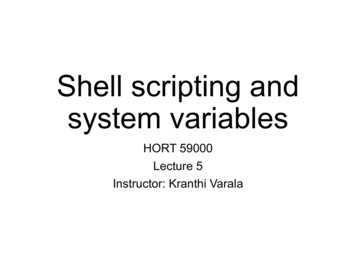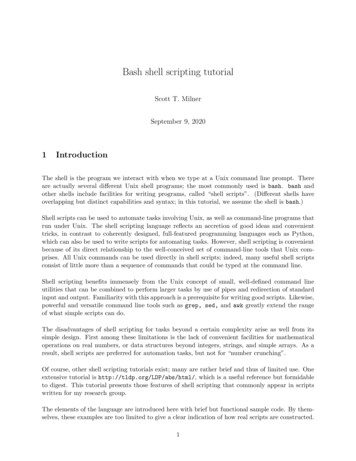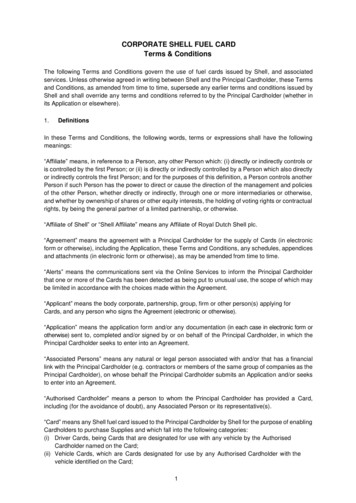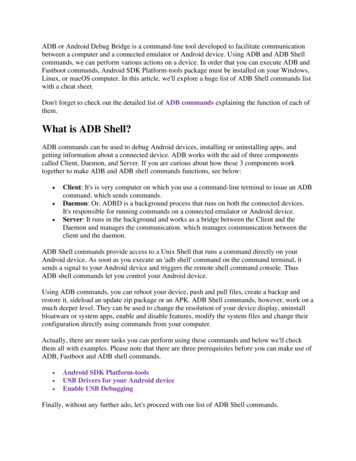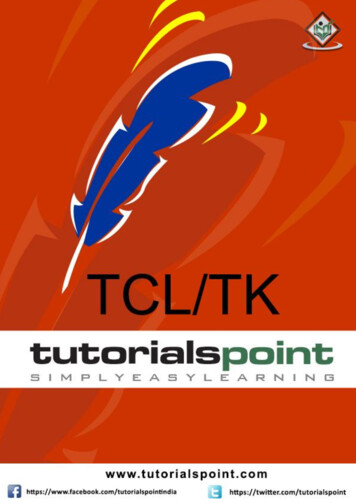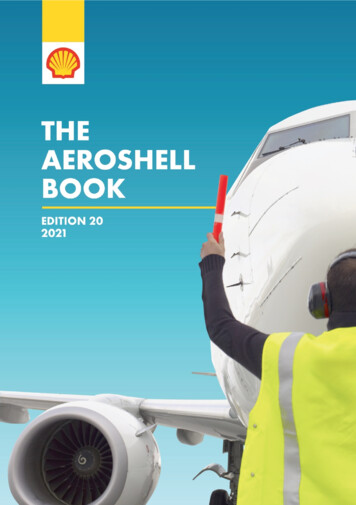
Transcription
THE AEROSHELL BOOKTwentieth Edition 2021Issued by:Shell AviationShell International Petroleum Co. Ltd.Shell CentreYork RoadLondonSE1 7NAwww.shell.com/aviation3
COPYRIGHT STATEMENTAll rights reserved. Neither the whole nor any part of this document may be reproduced,stored in any retrieval system or transmitted in any form or by any means (electronic,mechanical, reprographic, recording or otherwise) without the prior written consent of thecopyright owner.The companies in which Royal Dutch Shell plc directly and indirectly owns investments areseparate entities. In this document the expressions “Shell”, “Group” and “Shell Group”are sometimes used for convenience where references are made to Group companies ingeneral. Likewise, the words “we”, “us” and “our” are also used to refer to Groupcompanies in general or those who work for them. These expressions are also used wherethere is no purpose in identifying specific companies. 2021 Shell International Petroleum Company Limited.4
DEFINITIONS & CAUTIONARY NOTEThe companies in which Royal Dutch Shell plc directly and indirectly owns investments areseparate legal entities. In this The AeroShell Book, “Shell”, “Shell Group” and “RoyalDutch Shell” are sometimes used for convenience where references are made to RoyalDutch Shell plc and its subsidiaries in general. Likewise, the words “we”, “us” and “our”are also used to refer to Royal Dutch Shell plc and its subsidiaries in general or to thosewho work for them. These terms are also used where no useful purpose is served byidentifying the particular entity or entities. ‘‘Subsidiaries’’, “Shell subsidiaries” and “Shellcompanies” as used in this The AeroShell Book refer to entities over which Royal DutchShell plc either directly or indirectly has control. Entities and unincorporated arrangementsover which Shell has joint control are generally referred to as “joint ventures” and “jointoperations”, respectively. Entities over which Shell has significant influence but neithercontrol nor joint control are referred to as “associates”. The term “Shell interest” is usedfor convenience to indicate the direct and/or indirect ownership interest held by Shell inan entity or unincorporated joint arrangement, after exclusion of all third-party interest.This The AeroShell Book contains forward-looking statements (within the meaning of theU.S. Private Securities Litigation Reform Act of 1995) concerning the financial condition,results of operations and businesses of Royal Dutch Shell. All statements other thanstatements of historical fact are, or may be deemed to be, forward-looking statements.Forward-looking statements are statements of future expectations that are based onmanagement’s current expectations and assumptions and involve known and unknownrisks and uncertainties that could cause actual results, performance or events to differmaterially from those expressed or implied in these statements. Forward-lookingstatements include, among other things, statements concerning the potential exposure ofRoyal Dutch Shell to market risks and statements expressing management’s expectations,beliefs, estimates, forecasts, projections and assumptions. These forward-lookingstatements are identified by their use of terms and phrases such as “aim”, “ambition”,‘‘anticipate’’, ‘‘believe’’, ‘‘could’’, ‘‘estimate’’, ‘‘expect’’, ‘‘goals’’, ‘‘intend’’, ‘‘may’’,‘‘objectives’’, ‘‘outlook’’, ‘‘plan’’, ‘‘probably’’, ‘‘project’’, ‘‘risks’’, “schedule”, ‘‘seek’’,‘‘should’’, ‘‘target’’, ‘‘will’’ and similar terms and phrases. There are a number of factorsthat could affect the future operations of Royal Dutch Shell and could cause those resultsto differ materially from those expressed in the forward-looking statements included in thisThe AeroShell Book, including (without limitation): (a) price fluctuations in crude oil and5
natural gas; (b) changes in demand for Shell’s products; (c) currency fluctuations; (d)drilling and production results; (e) reserves estimates; (f) loss of market share and industrycompetition; (g) environmental and physical risks; (h) risks associated with theidentification of suitable potential acquisition properties and targets, and successfulnegotiation and completion of such transactions; (i) the risk of doing business indeveloping countries and countries subject to international sanctions; (j) legislative, fiscaland regulatory developments including regulatory measures addressing climate change;(k) economic and financial market conditions in various countries and regions; (l) politicalrisks, including the risks of expropriation and renegotiation of the terms of contracts withgovernmental entities, delays or advancements in the approval of projects and delays inthe reimbursement for shared costs; (m) risks associated with the impact of pandemics,such as the COVID-19 (coronavirus) outbreak; and (n) changes in trading conditions. Noassurance is provided that future dividend payments will match or exceed previousdividend payments. All forward-looking statements contained in this The AeroShell Bookare expressly qualified in their entirety by the cautionary statements contained or referredto in this section. Readers should not place undue reliance on forward-looking statements.Additional risk factors that may affect future results are contained in Royal Dutch Shell’sForm 20-F for the year ended December 31, 2019 (available at www.shell.com/investorand www.sec.gov). These risk factors also expressly qualify all forward-looking statementscontained in this The AeroShell Book and should be considered by the reader. Eachforward-looking statement speaks only as of the date of this The AeroShell Book, January1, 2021. Neither Royal Dutch Shell plc nor any of its subsidiaries undertake any obligationto publicly update or revise any forward-looking statement as a result of new information,future events or other information. In light of these risks, results could differ materially fromthose stated, implied or inferred from the forward-looking statements contained in this TheAeroShell Book.We may have used certain terms, such as resources, in this The AeroShell Book that theUnited States Securities and Exchange Commission (SEC) strictly prohibits us fromincluding in our filings with the SEC. Investors are urged to consider closely the disclosurein our Form 20-F, File No 1-32575, available on the SEC website www.sec.gov.6
CONTENTSCOPYRIGHT STATEMENT . 4DEFINITIONS & CAUTIONARY NOTE . 5CONTENTS . 71.INTRODUCTION . 14AEROSHELL TIMELINE . 15GENERAL NOTES ON AEROSHELL PRODUCTS. 17DISCONTINUED AEROSHELL GRADES .25ENVIRONMENTAL NOTES .29QUALITY CONTROL, STORAGE, HANDLING AND RETESTING OF AEROSHELLPRODUCTS . 31RECOMMENDED STORAGE. 38SHELL AVIATION SERVICE.392.SHELL AVIATION FUELS . 46INTRODUCTION TO AVIATION FUELS . 46ACCESS TO AVIATION FUEL SPECIFICATIONS . 57AVIATION FUEL ADDITIVES. 59FUEL PROPERTIES NOT IN SPECIFICATIONS. 61SHELL AEROJET .62AEROSHELL PERFORMANCE ADDITIVE 101 .63SHELL WATER DETECTOR . 673.AEROSHELL PISTON ENGINE OILS . 70SPECIFICATIONS . 71FUNCTION OF PISTON ENGINE OIL .72APPLICATION .72UNDERSTANDING MULTIGRADES . 74UNDERSTANDING ADDITIVES .787
OIL SERVICING . 81LOW OIL TEMPERATURE. 95LEAD FOULING . 96WATER INGESTION IN ENGINE OIL .98PREPARATION FOR AIRCRAFT STORAGE . 99RADIAL ENGINES . 105VINTAGE AIRCRAFT . 106NON-AVIATION USE OF AEROSHELL PISTON ENGINE OILS . 106STABILITY IN STORAGE . 106AEROSHELL OILS 65, 80, 100 and 120 . 107AEROSHELL OILS W80, W100 and W120 . 109AEROSHELL OIL W 15W-50 . 113AEROSHELL OILS W80 PLUS and W100 PLUS .117AEROSHELL OIL SPORT PLUS 4 .119AEROSHELL OIL DIESEL ULTRA . 121TYPICAL TEMPERATURE/VISCOSITY CURVES OF AEROSHELL OILS. 1234.AEROSHELL TURBINE ENGINE OILS . 126VINTAGE AIRCRAFT . 130OIL ANALYSIS . 130APPLICATIONS.131OIL APPROVALS .131TYPICAL PROPERTIES .131COMPRESSOR WASHING .131OIL CHANGE INTERVAL . 132OIL CHANGEOVER . 132COMPATIBILITY WITH MATERIALS . 133NON-AVIATION USE OF AEROSHELL TURBINE ENGINE OILS. 137AEROSHELL TURBINE OIL 2. 1398
AEROSHELL TURBINE OIL 3.141AEROSHELL TURBINE OIL 308 . 143AEROSHELL TURBINE OIL 390 . 147AEROSHELL TURBINE OIL 500.151AEROSHELL TURBINE OIL 555 . 155AEROSHELL TURBINE OIL 560.161AEROSHELL TURBINE OIL 750. 167AEROSHELL ASCENDER .171AERO DERIVED IGTs: APPROVED STATUS OF AEROSHELL TURBINE OILS . 175TYPICAL TEMPERATURE/VISCOSITY CURVES OF AEROSHELL TURBINE OILS . 1775.AEROSHELL GREASES. 180ABOUT GREASES . 180COMPATIBILITY WITH MATERIALS . 185COMPATIBILITY AND INTERMIXING OF GREASES . 186GREASE SERVICING . 187APPLICATIONS. 189AEROSHELL GREASE 5. 193AEROSHELL GREASE 6. 195AEROSHELL GREASE 7. 197AEROSHELL GREASE 14 . 199AEROSHELL GREASE 22 . 201AEROSHELL GREASE 33 . 203AEROSHELL GREASE 58 . 207AEROSHELL GREASE 64 . 2096.AEROSHELL HYDRAULIC FLUIDS . 214BACKGROUND . 214APPLICATIONS. 215MAIN REQUIREMENTS. 2169
TYPICAL PROPERTIES . 216USEFUL OPERATING TEMPERATURE RANGE . 216COMPATIBILITY . 217CHANGEOVER . 217COMPATIBILITY WITH MATERIALS . 217TYPES OF HYDRAULIC FLUIDS . 218HYDRAULIC FLUID CLEANLINESS - SUPERCLEAN PROPERTIES . 219AEROSHELL HYDRAULIC FLUIDS IN NON-AVIATION APPLICATIONS . 220AEROSHELL FLUID 4 . 221AEROSHELL FLUID 31. 223AEROSHELL FLUID 41. 227AEROSHELL FLUID 61. 231AEROSHELL LGF . 235TYPICAL TEMPERATURE/VISCOSITY CURVE OF AEROSHELL HYDRAULIC FLUIDS . 2377.AEROSHELL PRESERVATIVES . 240AEROSHELL FLUID 2XN. 2438.OTHER AEROSHELL FLUIDS . 248ABOUT THE FLUIDS . 248AEROSHELL FLUID 3 . 251AEROSHELL FLUID 5M-A . 253AEROSHELL FLUID 12. 255AEROSHELL FLUID 602 . 257AEROSHELL FLUID S.8350 . 259AEROSHELL CALIBRATING FLUID 2 . 261AEROSHELL COMPOUND 07 . 263AEROSHELL SMOKE OIL. 265TYPICAL TEMPERATURE/VISCOSITY CURVE OF OTHER AEROSHELL FLUIDS . 2669.CONVERSION TABLES . 26810
TEMPERATURE CONVERSION CHART . 268MISCELLANEOUS CONVERSION CHART . 27110. AVIATION SPECIFICATIONS . 274AVIATION SPECIFICATIONS GUIDE . 274U.S. AVIATION SPECIFICATIONS . 279BRITISH AVIATION SPECIFICATIONS . 299NATO CODE NUMBERS . 319BRITISH JOINT SERVICE DESIGNATIONS. 331FRENCH AVIATION SPECIFICATIONS . 343RUSSIAN AVIATION SPECIFICATIONS . 349AEROSHELL PRODUCT SPECIFICATIONS . 36311
NOTES12
1. INTRODUCTIONShell companies manufacture and distribute throughout the world a full range of aviationproducts required for the operation and maintenance of aircraft of all types. This rangeincludes:Aviation Turbine FuelsAviation GasolinesAeroShell Turbine Engine OilsAeroShell Piston Engine OilsAeroShell GreasesAeroShell Hydraulic FluidsAeroShell FluidsAeroShell PreservativesThis manual contains information on the characteristics and specifications of theseproducts and offers guidance on their application.The Specification information provided is correct as known at the time of going to press.Due to the fact that commercial and military specifications for aviation products aresubject to frequent changes, it is advisable to consult the local Shell company, whoserepresentative will also give advice on availability (not all grades are always availableworldwide), prices and packaging and will be glad to answer any other queries.All reasonable care has been taken in the preparation of this publication; however, noresponsibility can be accepted for the consequences of any inaccuracy which it maycontain.14
AEROSHELL TIMELINE1940sLaunch of AeroShell Grease range1950sDeveloped Shell Water DetectorLaunch of AeroShell Oil W range, first to use ashless dispersants forcleaner enginesDevelopment of mineral and synthetic AeroShell Turbine Oils1960s1960 AeroShell Grease 14 for helicopters approved to MIL-G-255371961Microgel grease thickener trademark filed1964 Approval of high-temperature AeroShell Grease 5 & launch of5-cSt AeroShell Turbine Oil 500, approved to MIL-L-23699A1965 Approval of AeroShell Grease 61967 Approval of AeroShell Turbine Oil 555 for Rolls-Royce OlympusEngines (Concorde)1970s1972 AeroShell Grease 7 approved to MIL-G-23827A1976 Launch of advanced wheel-bearing grease AeroShell Grease 221980s1980s Launch of AeroShell Oil W 15W-50, the 1st semi-synthetic multigrade aviation oil1984 Launch of AeroShell Turbine Oil 560, a 3rd generation 5-cSt oil,approved to MIL-PRF-23699 HTS1985 Shell scientists develop new lithium soap thickener technology foraviation15
2010s2014Launch of AeroShell Grease 58, a Li-Cx wheel-bearing greaseexceeding SAE AMS3058 specification2018AeroShell Grease 58 approved by Airbus under AIMS09-06-0032000s2000s AeroShell Oil Sport Plus 2 and 4 developed with ROTAX, the 1stoils specifically for light sport aircraft engines2006 Launch of AeroShell Grease 33MS, renamed AeroShell Grease64 in 2015, an extreme pressure Li-Cx grease, approved to MIL-G21164D;AeroShell Oil Diesel 10W-40, now AeroShell Diesel Ultra,developed with SMA and Thielert, specifically for diesel aeroengines2007Launch of AeroShell Ascender, world’s 1st new TEO approved toSAE AS5780A HPC specification; AeroShell Grease 33approved by Airbus under AIMS09-06-0022009 Shell celebrates 100 years in aviation1990s1990s Launch of AeroShell Oil W 100 Plus1995Launch of AeroShell Grease 33 – 1st lithium-complex (Li-Cx)grease approved to MIL-PRF-23827 Type 1 and BMS 3-33A1997AeroShell LGF & SSF approved to BMS 3-3216
GENERAL NOTES ON AEROSHELL PRODUCTSThe notes contained in this section apply to the complete range of AeroShell products.Additional notes specific to each product group are given in the notes at the front of eachchapter.NotationThe brand names chosen for the range of AeroShell products comprise three parts: thename ‘AeroShell’ followed by the words ‘Turbine Oil’, ‘Fluid’, ‘Grease’, etc. and finally anumber and/or letters designating each product. The numbers do not always follow asequence. In the case of turbine and piston engine oils the number relates to the oilviscosity; for greases, fluids and compounds the numbers merely differentiate betweenproducts and gaps occur in the sequence due to obsolescence. Consequently an up-todate version of this book should always be used for reference purposes.ApplicationsUnder this heading the more important and known representative aviation uses havebeen named for each AeroShell Grade, and these are intended to serve as a generalindicator of the type of application for which the grade is normally suitable. Furtherconsultation with the component manufacturer is recommended in case of doubt.Whenever an aircraft is certified, all of the oils, greases and hydraulic fluids used on thataircraft are specified for each application point on the type certificate. The TypeCertificate will specify, either by specification number or by specific brand names, thosegrades which are qualified to be used. The U.S. Federal Aviation Administration (FAA)regulations state that only grades qualified for specific applications can be used incertified aircraft. Therefore it is the responsibility of the aircraft owner or designatedrepresentative to determine which grades should be used.Many AeroShell products are used in non-aviation applications especially where theoperating requirements or properties are at the extreme for industrial lubricants (forexample, high or low temperatures). Details are not included in this publication butfurther information is available from local Shell companies.17
In selecting an AeroShell Grade for a non-aviation application the properties of thegrade must be examined. This will only give an approximate indication as to theexpected performance in the specific application. However, such data must be regardedas guidance only. There is no laboratory test that can give a complete prediction ofperformance in the actual use, and the final stage in any decision must involveperformance tests in either the actual equipment or in the laboratory/test house underconditions expected in service.SpecificationsThe majority of AeroShell products are manufactured to comply with British or U.S.Government Specifications because these are acceptable to most aircraft manufacturersand airline operators. In certain cases where no suitable specification exists, Shellproducts have been developed to meet specific performance requirements.Many of the British and U.S. Government Specifications (as well as those of other NATOcountries) are interchangeable, although the specifications are not identical. The words‘approved’, ‘meets’, ‘equivalent’ and ‘corresponding’ have been used in the text todefine the relationship between products and specifications; the precise meaning of theseterms is as follows:Approved indicates that the product has been manufactured to meet the requirementsof the specification, and against which it has been approved (where type approval isrequired).Meets indicates that the product complies with the requirements of the specificationand, either type approval is being obtained, or because the specification is now obsolete,it is not possible to obtain type approval (where type approval is required).Equivalent indicates that the product complies with the major requirements of thespecification but has not necessarily been manufactured to the specification.Corresponding indicates that the product has not been manufactured to meet thespecification and that it is the nearest product available.The letters ‘DEF’, ‘DEF STAN’, ‘DTD’, ‘DED’, ‘D.Eng.R.D.’, ‘D.Eng.D’, ‘DERD’, ‘CS’, ‘TS’and ‘BS’ refer to British Specifications; ‘MIL’ and ‘DOD’ refer to American Specifications.18
As an aid to users, details of French and Russian Specifications are included butspecifications of other countries are not included.Over the years, changes were made to both U.S. and British Specifications. The U.S.authorities eliminated the older MIL specifications (e.g. H hydraulic fluids; L lubricating oils; G greases) as they are currently known and replace them withperformance specifications. These will be labelled MIL-PRF- followed by a number. ManyMIL-PRF- specifications have now been issued and others will follow until all current MILspecifications have been converted. The numeric part of the MIL-PRF- designation is thesame as the numeric part of the MIL specification it replaces; however, the letter whichdenotes the Revision level has also changed. MIL specifications which are cancelled orobsolete will not be changed. A small number of MIL specifications have been convertedto MIL-DTL- specifications, where DTL represents ‘detail’.For certain products, the U.S. authorities have decided to no longer maintain militaryspecifications; in these cases, they have been converted to civil specifications by the SAE(Society of Automotive Engineers).Examples of these changes include:MIL-H-5606G became MIL-PRF-5606HMIL-L-23699E became MIL-PRF-23699FMIL-G-23827B became MIL-PRF-23827CMIL-T-83133D became MIL-DTL-83133EMIL-G-4343C became SAE AMSG4343British specifications are being standardised on Defence Standards (commonly referredto as DEF STAN). The changeover is virtually complete and all current DERD, DTD, CSand TS specifications have now been converted to DEF STAN specifications; in doing so,the numeric part has also been changed. Obsolete or Cance
This The AeroShell Book contains forward-looking statements (within the meaning of the U.S. Private Securities Litigation Reform Act of 1995) concerning the financial condition, results of operations and businesses of Royal Dutch Shell. All statements other than statements of historical fact are, or may be deemed to be, forward-looking statements.



